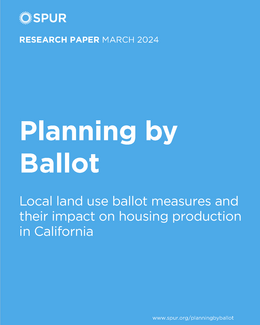SPUR has created the most up-to-date database of local land use ballot measures that impact housing production in the State of California.
Californians have shown up at the ballot box to shape the patterns and nature of growth in their communities since the 1970s. Adopted citizen- and city-led initiatives have included urban growth boundaries, hillside protection ordinances, and general open space or agricultural land preservation. Notably, these initiatives effectively freeze the land use changes they describe — unless they are repealed through another popular vote.
Many of the 208 measures identified by SPUR’s research curb urban sprawl and protect open space by limiting new development to already-urbanized areas. But without concurrent incentives to promote “infill” development of vacant or underutilized land in urbanized areas, they have the potential to limit the supply of housing overall. Moreover, other growth management ballot measures that have passed within city boundaries — such as zoning restrictions, voter approval requirements, height and bulk limits, and infrastructure provisions or parking requirements — have had a direct negative impact on infill housing production. Over the long term, measures that restrict infill housing can undermine housing affordability and have the potential to exacerbate racial segregation.
